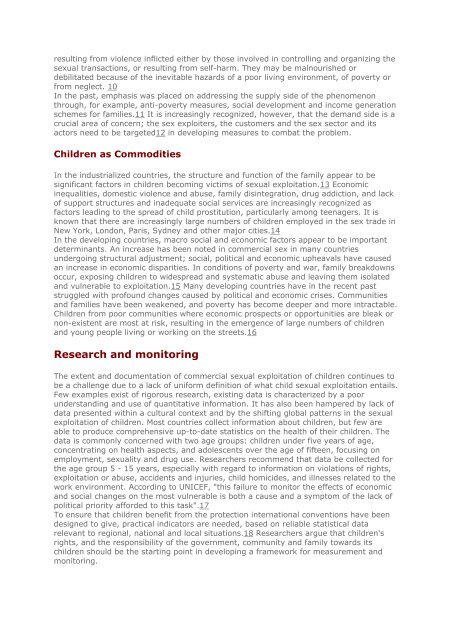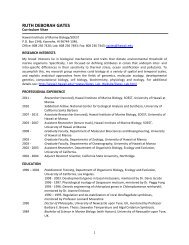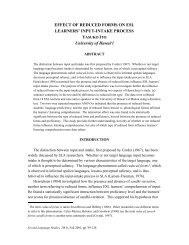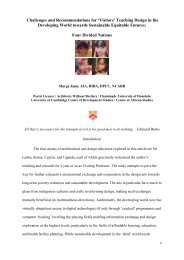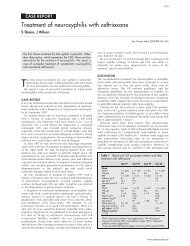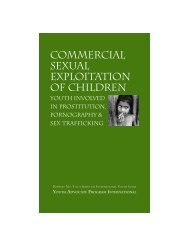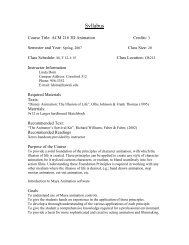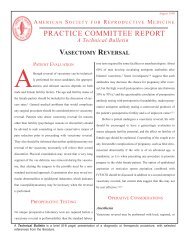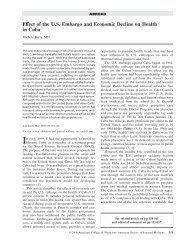Commercial Sexual Exploitation of Children: An Overview (PDF)
Commercial Sexual Exploitation of Children: An Overview (PDF)
Commercial Sexual Exploitation of Children: An Overview (PDF)
You also want an ePaper? Increase the reach of your titles
YUMPU automatically turns print PDFs into web optimized ePapers that Google loves.
esulting from violence inflicted either by those involved in controlling and organizing the<br />
sexual transactions, or resulting from self-harm. They may be malnourished or<br />
debilitated because <strong>of</strong> the inevitable hazards <strong>of</strong> a poor living environment, <strong>of</strong> poverty or<br />
from neglect. 10<br />
In the past, emphasis was placed on addressing the supply side <strong>of</strong> the phenomenon<br />
through, for example, anti-poverty measures, social development and income generation<br />
schemes for families.11 It is increasingly recognized, however, that the demand side is a<br />
crucial area <strong>of</strong> concern; the sex exploiters, the customers and the sex sector and its<br />
actors need to be targeted12 in developing measures to combat the problem.<br />
<strong>Children</strong> as Commodities<br />
In the industrialized countries, the structure and function <strong>of</strong> the family appear to be<br />
significant factors in children becoming victims <strong>of</strong> sexual exploitation.13 Economic<br />
inequalities, domestic violence and abuse, family disintegration, drug addiction, and lack<br />
<strong>of</strong> support structures and inadequate social services are increasingly recognized as<br />
factors leading to the spread <strong>of</strong> child prostitution, particularly among teenagers. It is<br />
known that there are increasingly large numbers <strong>of</strong> children employed in the sex trade in<br />
New York, London, Paris, Sydney and other major cities.14<br />
In the developing countries, macro social and economic factors appear to be important<br />
determinants. <strong>An</strong> increase has been noted in commercial sex in many countries<br />
undergoing structural adjustment; social, political and economic upheavals have caused<br />
an increase in economic disparities. In conditions <strong>of</strong> poverty and war, family breakdowns<br />
occur, exposing children to widespread and systematic abuse and leaving them isolated<br />
and vulnerable to exploitation.15 Many developing countries have in the recent past<br />
struggled with pr<strong>of</strong>ound changes caused by political and economic crises. Communities<br />
and families have been weakened, and poverty has become deeper and more intractable.<br />
<strong>Children</strong> from poor communities where economic prospects or opportunities are bleak or<br />
non-existent are most at risk, resulting in the emergence <strong>of</strong> large numbers <strong>of</strong> children<br />
and young people living or working on the streets.16<br />
Research and monitoring<br />
The extent and documentation <strong>of</strong> commercial sexual exploitation <strong>of</strong> children continues to<br />
be a challenge due to a lack <strong>of</strong> uniform definition <strong>of</strong> what child sexual exploitation entails.<br />
Few examples exist <strong>of</strong> rigorous research, existing data is characterized by a poor<br />
understanding and use <strong>of</strong> quantitative information. It has also been hampered by lack <strong>of</strong><br />
data presented within a cultural context and by the shifting global patterns in the sexual<br />
exploitation <strong>of</strong> children. Most countries collect information about children, but few are<br />
able to produce comprehensive up-to-date statistics on the health <strong>of</strong> their children. The<br />
data is commonly concerned with two age groups: children under five years <strong>of</strong> age,<br />
concentrating on health aspects, and adolescents over the age <strong>of</strong> fifteen, focusing on<br />
employment, sexuality and drug use. Researchers recommend that data be collected for<br />
the age group 5 - 15 years, especially with regard to information on violations <strong>of</strong> rights,<br />
exploitation or abuse, accidents and injuries, child homicides, and illnesses related to the<br />
work environment. According to UNICEF, "this failure to monitor the effects <strong>of</strong> economic<br />
and social changes on the most vulnerable is both a cause and a symptom <strong>of</strong> the lack <strong>of</strong><br />
political priority afforded to this task".17<br />
To ensure that children benefit from the protection international conventions have been<br />
designed to give, practical indicators are needed, based on reliable statistical data<br />
relevant to regional, national and local situations.18 Researchers argue that children's<br />
rights, and the responsibility <strong>of</strong> the government, community and family towards its<br />
children should be the starting point in developing a framework for measurement and<br />
monitoring.


